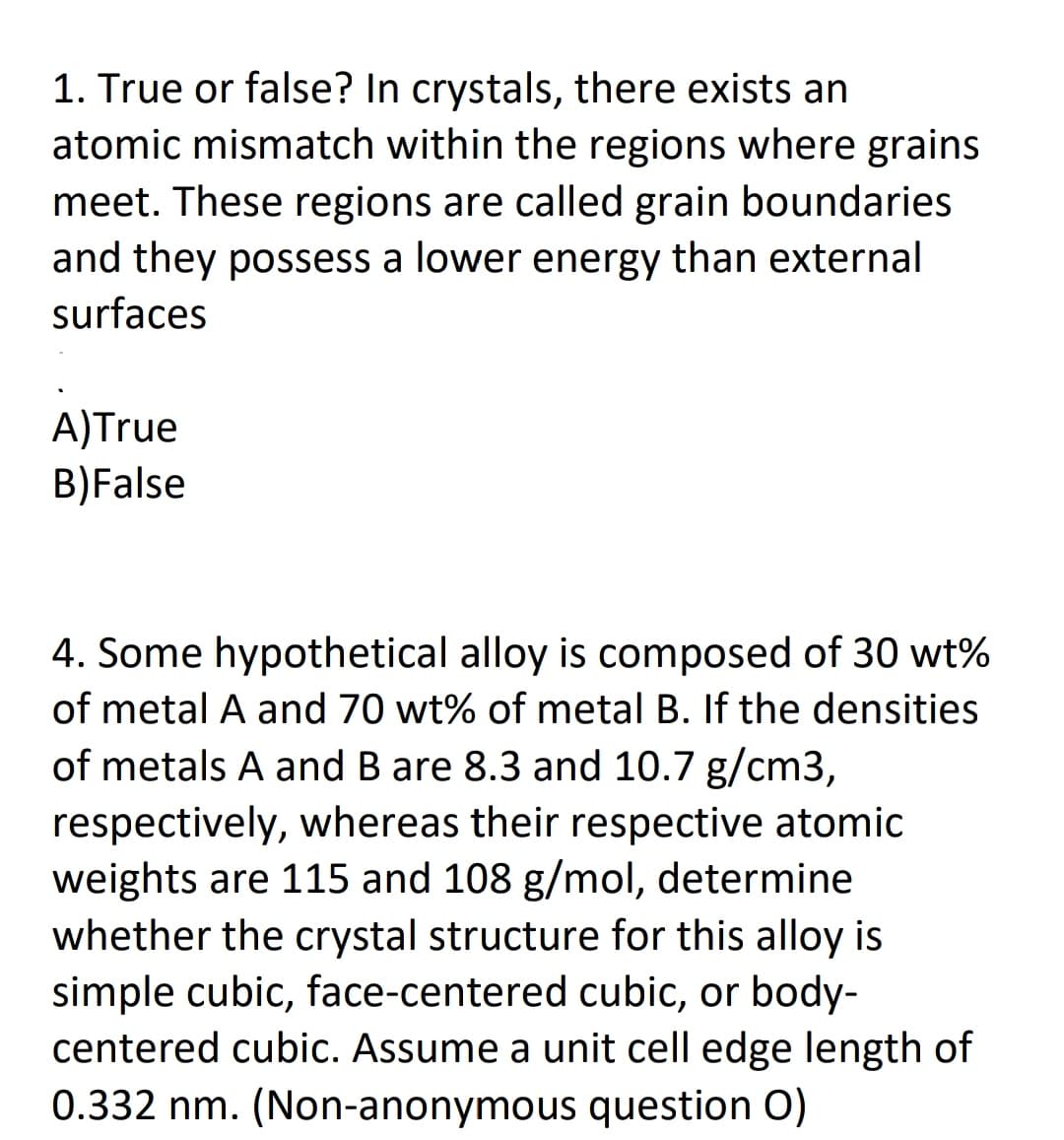1. True or false? In crystals, there exists an atomic mismatch within the regions where grains meet. These regions are called grain boundaries and they possess a lower energy than external surfaces A)True B)False 4. Some hypothetical alloy is composed of 30 wt% of metal A and 70 wt% of metal B. If the densities of metals A and B are 8.3 and 10.7 g/cm3, respectively, whereas their respective atomic weights are 115 and 108 g/mol, determine whether the crystal structure for this alloy is simple cubic, face-centered cubic, or body- centered cubic. Assume a unit cell edge length of 0.332 nm. (Non-anonymous question O)
1. True or false? In crystals, there exists an atomic mismatch within the regions where grains meet. These regions are called grain boundaries and they possess a lower energy than external surfaces A)True B)False 4. Some hypothetical alloy is composed of 30 wt% of metal A and 70 wt% of metal B. If the densities of metals A and B are 8.3 and 10.7 g/cm3, respectively, whereas their respective atomic weights are 115 and 108 g/mol, determine whether the crystal structure for this alloy is simple cubic, face-centered cubic, or body- centered cubic. Assume a unit cell edge length of 0.332 nm. (Non-anonymous question O)
Materials Science And Engineering Properties
1st Edition
ISBN:9781111988609
Author:Charles Gilmore
Publisher:Charles Gilmore
Chapter4: Temperature Effects On Atom Arrangements And Atom Motion
Section: Chapter Questions
Problem 4.24P
Related questions
Question
material science

Transcribed Image Text:1. True or false? In crystals, there exists an
atomic mismatch within the regions where grains
meet. These regions are called grain boundaries
and they possess a lower energy than external
surfaces
A)True
B)False
4. Some hypothetical alloy is composed of 30 wt%
of metal A and 70 wt% of metal B. If the densities
of metals A and B are 8.3 and 10.7 g/cm3,
respectively, whereas their respective atomic
weights are 115 and 108 g/mol, determine
whether the crystal structure for this alloy is
simple cubic, face-centered cubic, or body-
centered cubic. Assume a unit cell edge length of
0.332 nm. (Non-anonymous question O)
Expert Solution
This question has been solved!
Explore an expertly crafted, step-by-step solution for a thorough understanding of key concepts.
This is a popular solution!
Trending now
This is a popular solution!
Step by step
Solved in 2 steps with 1 images

Knowledge Booster
Learn more about
Need a deep-dive on the concept behind this application? Look no further. Learn more about this topic, civil-engineering and related others by exploring similar questions and additional content below.Recommended textbooks for you

Materials Science And Engineering Properties
Civil Engineering
ISBN:
9781111988609
Author:
Charles Gilmore
Publisher:
Cengage Learning

Materials Science And Engineering Properties
Civil Engineering
ISBN:
9781111988609
Author:
Charles Gilmore
Publisher:
Cengage Learning